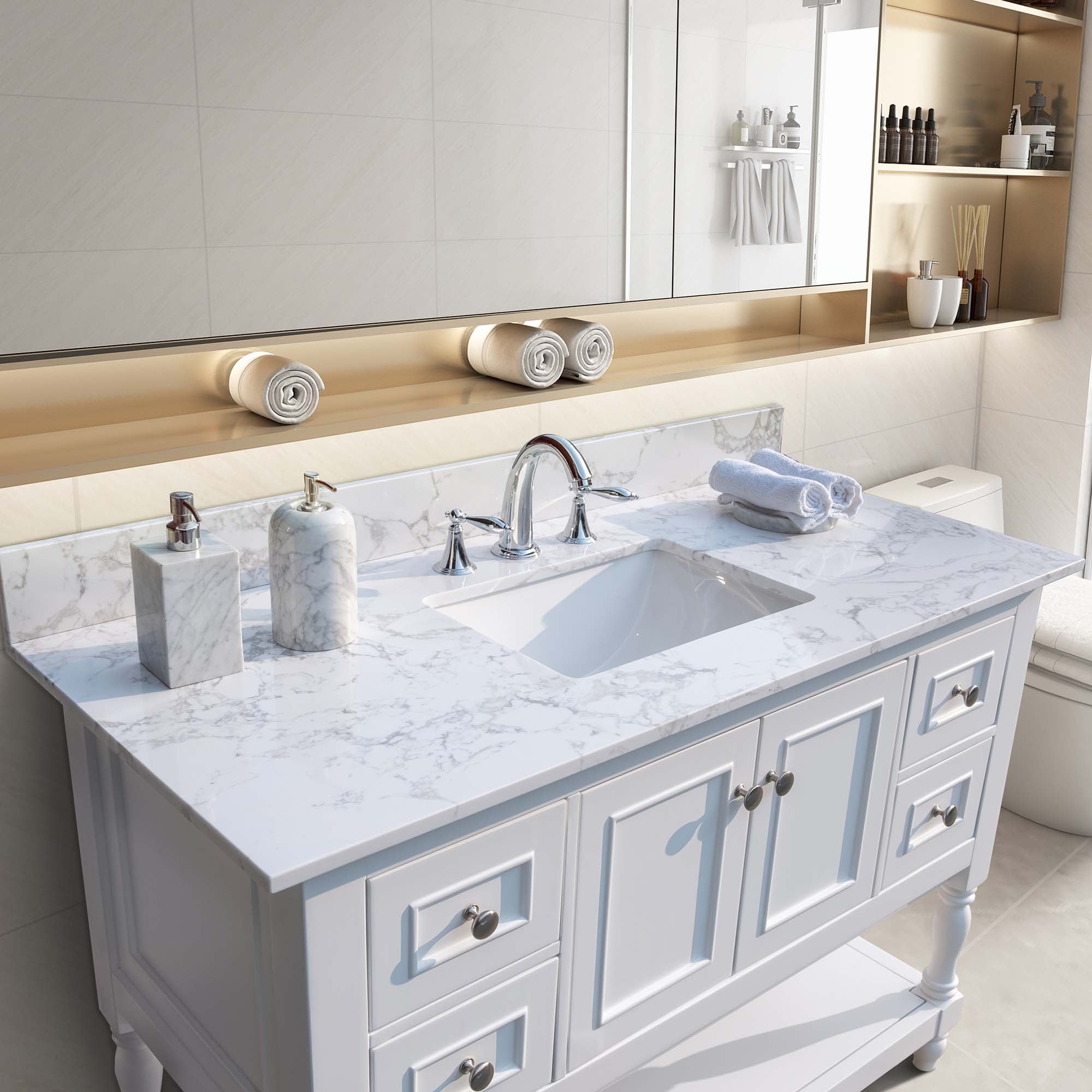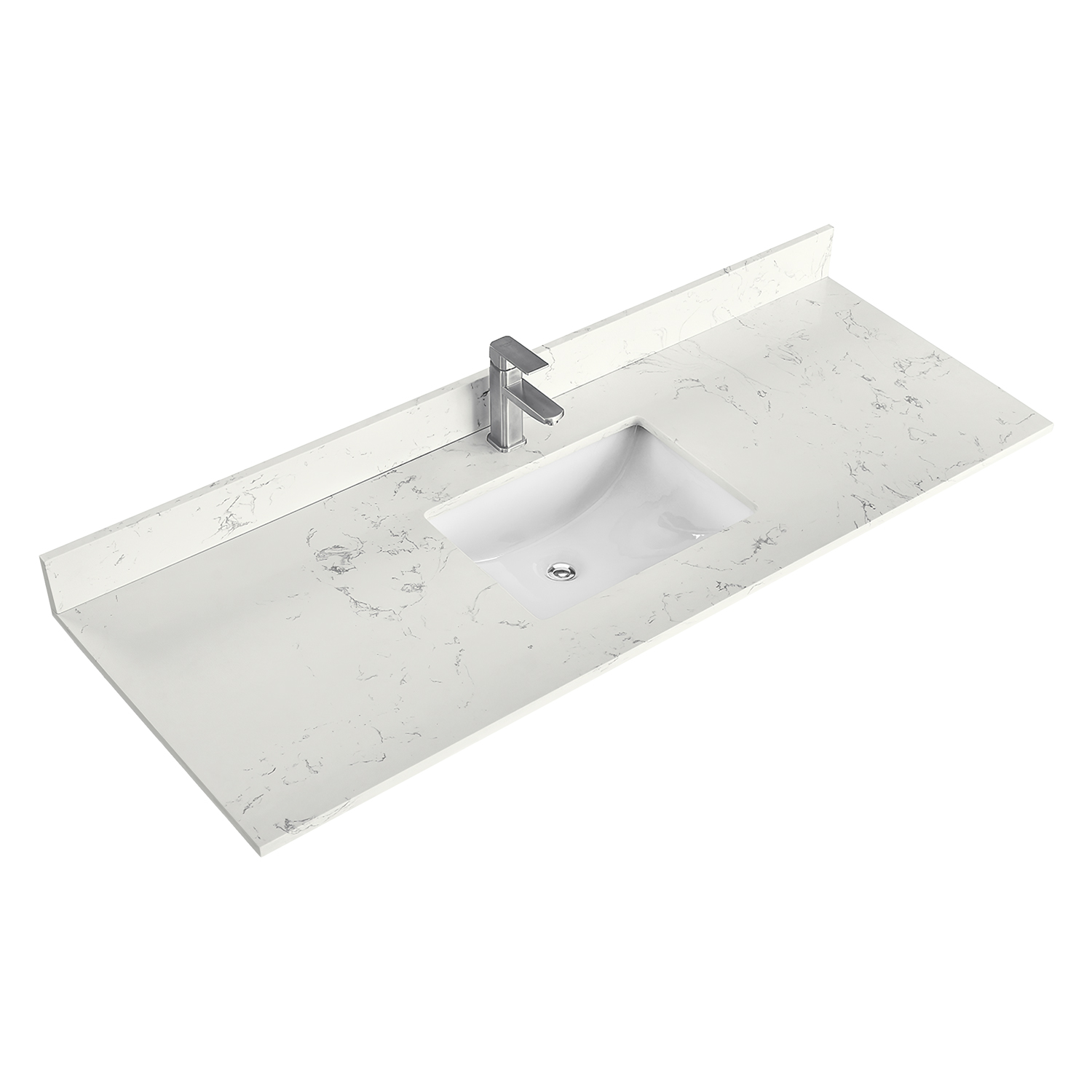Choosing the Right Material

The countertop is a focal point in any bathroom, and choosing the right material for your 60-inch vanity is crucial for both aesthetics and functionality. Each material offers a unique combination of durability, maintenance requirements, cost, and aesthetic appeal.
Countertop Material Comparison
Understanding the pros and cons of popular countertop materials will help you make an informed decision. Here’s a detailed comparison:
| Material | Durability | Maintenance | Cost | Aesthetic Appeal |
|---|---|---|---|---|
| Granite | Highly durable, resistant to scratches, heat, and stains | Requires regular sealing to prevent staining, prone to etching from acidic substances | High | Natural stone with unique patterns and colors |
| Marble | Durable but susceptible to scratches, heat, and staining | Requires regular sealing, prone to etching from acidic substances | High | Elegant and classic, available in a wide range of colors and patterns |
| Quartz | Extremely durable, resistant to scratches, heat, and stains | Low maintenance, non-porous and doesn’t require sealing | Medium to high | Wide range of colors and patterns, often mimicking natural stone |
| Engineered Stone | Durable, resistant to scratches and stains | Low maintenance, non-porous and doesn’t require sealing | Medium | Wide range of colors and patterns, often mimicking natural stone |
Design Tips for Incorporating Countertop Materials
- Modern Bathroom: Quartz or engineered stone with sleek, minimalist designs and solid colors like white, gray, or black complement modern aesthetics.
- Traditional Bathroom: Marble or granite with intricate veining and warm tones like cream, beige, or brown enhance traditional bathroom designs.
- Farmhouse Bathroom: Engineered stone or granite with a rustic finish or natural patterns like wood grain or veining create a warm and inviting farmhouse feel.
Design Considerations for a 60-Inch Vanity: 60 Inch Bathroom Vanity Countertops

A 60-inch vanity offers ample space and storage for a bathroom, but its size demands careful planning to ensure it complements the overall layout and enhances functionality.
Vanity Placement and Bathroom Size
A 60-inch vanity can dominate a small bathroom, making the space feel cramped and overwhelming. Consider the bathroom’s square footage and layout before choosing a vanity of this size. For instance, a bathroom with limited square footage may benefit from a smaller vanity or a more compact design to maximize floor space. Conversely, a spacious bathroom can comfortably accommodate a 60-inch vanity, providing a statement piece and a sense of grandeur.
Maximizing Storage and Functionality, 60 inch bathroom vanity countertops
A 60-inch vanity offers significant storage potential, but its design can greatly influence its functionality.
- Drawers: Deep drawers are ideal for storing larger items like towels, toiletries, and styling tools. Consider drawers with built-in dividers or organizers for increased efficiency.
- Cabinets: Cabinets provide vertical storage for items like hairdryers, styling products, and extra towels. Look for cabinets with adjustable shelves for flexible storage options.
- Open Shelving: Open shelves offer easy access to frequently used items like hand towels, soap, and decorative accents. However, they may require more careful organization to maintain a clutter-free appearance.
Different Vanity Designs
A 60-inch vanity can be customized to suit various design preferences and bathroom layouts.
- Single-Sink Vanity: A single-sink vanity offers a classic and practical option, providing ample counter space for a single person. It is ideal for smaller bathrooms or those with limited plumbing access.
- Double-Sink Vanity: A double-sink vanity is perfect for couples or families, providing two separate sinks and counter spaces for added convenience. It is particularly well-suited for larger bathrooms with ample space.
- Freestanding Vanity: A freestanding vanity offers a modern and stylish alternative to traditional wall-mounted designs. It can be placed anywhere in the bathroom, creating a focal point and adding visual interest.
Installation and Maintenance

Installing a 60-inch vanity countertop requires careful planning and execution to ensure a seamless and durable installation. This section will Artikel the steps involved in installing a 60-inch vanity countertop, along with recommended cleaning and maintenance procedures for various countertop materials.
Installing a 60-Inch Vanity Countertop
Installing a 60-inch vanity countertop involves several steps, including cutting, sealing, and attaching the countertop to the vanity base.
- Measure and Cut the Countertop: Measure the vanity base accurately and mark the countertop for cutting. Use a specialized countertop saw or a circular saw with a diamond blade to cut the countertop to the desired size. Ensure the cuts are precise and clean to avoid any gaps or unevenness.
- Seal the Edges: After cutting, apply a sealant to the edges of the countertop to prevent water damage and staining. This is especially important for porous materials like natural stone. Allow the sealant to dry completely before proceeding.
- Attach the Countertop to the Vanity Base: Depending on the countertop material and vanity base construction, there are various methods for attaching the countertop. Some common methods include using construction adhesive, clamps, or screws. Ensure the countertop is securely attached to the vanity base, creating a solid and stable installation.
Cleaning and Maintenance
Proper cleaning and maintenance are crucial for maintaining the beauty and longevity of your vanity countertop.
- Natural Stone: Natural stone countertops require regular cleaning with a mild soap and water solution. Avoid using abrasive cleaners or acidic substances that can damage the stone’s finish. Periodically seal the countertop to prevent staining and water damage.
- Quartz: Quartz countertops are known for their durability and low maintenance. They can be cleaned with a mild soap and water solution or a dedicated quartz cleaner. Avoid using harsh chemicals or abrasive cleaners that can scratch the surface.
- Laminate: Laminate countertops are relatively easy to maintain. Clean them with a damp cloth and mild soap. Avoid using abrasive cleaners or harsh chemicals that can damage the laminate surface.
Preventing Countertop Issues
Here are some tips to prevent common countertop issues like scratches, stains, and water damage:
- Use Cutting Boards: Always use cutting boards when preparing food on your countertop to prevent scratches and damage. Choose a cutting board that is specifically designed for your countertop material.
- Clean Up Spills Immediately: Clean up spills immediately to prevent staining and water damage. Use a damp cloth and mild soap to wipe up spills. Avoid using harsh chemicals or abrasive cleaners that can damage the countertop surface.
- Use Coasters and Trivets: Use coasters and trivets to protect your countertop from heat damage caused by hot pots, pans, or appliances. Choose coasters and trivets that are made of materials that won’t scratch or damage your countertop.
